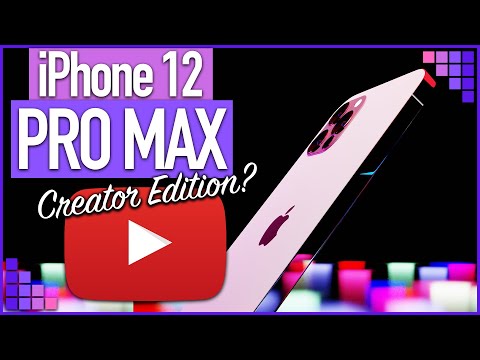0:00 intro
1:09 iPhone 12 Pro Max Cameras
9:15 iPhone 12 Pro Max Microphones
10:35 Editing on iPhone 12 Pro Max
13:17 Publishing Videos from iPhone
15:42 Promoting your Youtube Videos on Social Media
iPhone 12 Pro Max renders via https://twitter.com/sismconcepts
Children’s Cancer Trust
https://www.cclg.org.uk/ccam
Mics
Boya Lav Mic https://amzn.to/3lRWGX3
Rode Shotgun Mics https://amzn.to/32XZ8T6
(Affiliate links)
Camera
Most likely we’ll see a similar camera setup to the iPhone 11 Pro, with a 12mp f1.8 wide angle, a 12mp f2.0 telephoto and a 12mp f2.4 Ultrawide camera on the back shooting 4K at up to 60 FPS, and 1080p at 240fps, though it looks like the 12Pro will be able to shoot 4K at the higher 240fps frame rates for buttery smooth sharp slow motion video.
The selfie camera too is a 12mp sensor, shooting 4K at up to 60fps and 1080p At 120fps so also very capable. We’ve seen no rumours of changes to this camera specifically.
What is changing that we know about with the iPhone 12 Pro and Pro Max is the addition of Lidar, a technology which allows the iPhone to create a depth map, much like FaceID’s TrueDepth sensors and combined with the A14’s Neural engine, I think we’ll be seeing Portrait Video, bringing the blurry, post shooting adjustable backgrounds to moving video for the first time in an iPhone.
So what else do vloggers love in a camera? Sharp autofocus and a flip out screen are normal favourites, but with a 12MP selfie sensor, the screen doesn’t need to flip, its already looking your way. In terms of focus, Jon Prosser’s leaked screenshots mention in settings the use of the Lidar sensor to assist with focus and identifying subjects, so that should be drastically improved too.
One of the beauties of shooting on an iPhone is it does most of the heavy lifting to intelligently get the best possible shot. It’ll adjust exposure, saturation and focus in real time to give you what it thinks is the best shot. Thats why for most people, an iPhone will give drastically better results than using a DSLR or Mirrorless dedicated camera. If you don’t know what you’re doing with the settings, lens choice, maintenance etc, the iPhone will give you better results most of the time.
But if you do want more control, you want your exposure and focus set just so, or want a flat colour profile so that you can grade it in post and get exactly what you want, there are apps like Filmic Pro. And if any of the things I said there didn’t really mean anything to you, you probably don’t need it.
Filmic Pro lets you adjust frame rates, bitrate, pull focus fine control and lock focus and exposure, shoot in different colour profiles and much more. So if you’re used to a high end camera and know what you’re doing, you can get incredible results with an iPhone.
Even iPhone’s microphones aren’t bad, can record good stereo, can eliminate some background noise and more, though a decent mic is always a good shout.
Editing
OK, so you’ve shot your video, its time to edit it into something ready for your channel. Apple includes iMovie as a free app now on iOS, MacOS and iPad, so you can do basic editing on there from day one and call it good, but if you’re wanting to do more, LumaFusion is a wonderful app that works across iPhone and iPad and brings a surprising amount of editing grunt to mobile editing.
You can do everything from your cut to adding titles, colour grading your footage, adding your b-roll and sound track, everything you’d expect, just in a pocket sized package. LumaFusion is £19.99 here in the UK and I believe $20 in the US, but worth every penny. Of course, if you have an iPad as well as your phone, LumaFusion is more comfortable on the larger screen, allowing everything a bit more space.
And of course, there’s every chance that Apple will be bringing Final Cut Pro to iPad & maybe even iPhone in the next 12 months as Apple Silicon rolls out and the code is made available for iPhone and iPad processors, which are very similar to the forthcoming Apple Silicon Mac processors, so that would make a huge difference to content creation on these devices.
Publishing
Unlike the vast majority of dedicated cameras, because the iPhone is an internet connected device, you can upload directly from the same device you shot and edited your video on.
Youtubers can use apps like Canva or Pixelmator to create their thumbnail artwork as well as uploading the videos directly to the platform from their phone and in most cases, directly from the editing app that they use to export the file.
Promotion
A huge part of success on YouTube comes down to getting eyes on the work you’ve done, and there are some social platforms that you can’t even interact on from a desktop or laptop, so the iPhone is of course the best platform for this too.
